Bryan Wilder
Predicting Language Models' Success at Zero-Shot Probabilistic Prediction
Sep 18, 2025Abstract:Recent work has investigated the capabilities of large language models (LLMs) as zero-shot models for generating individual-level characteristics (e.g., to serve as risk models or augment survey datasets). However, when should a user have confidence that an LLM will provide high-quality predictions for their particular task? To address this question, we conduct a large-scale empirical study of LLMs' zero-shot predictive capabilities across a wide range of tabular prediction tasks. We find that LLMs' performance is highly variable, both on tasks within the same dataset and across different datasets. However, when the LLM performs well on the base prediction task, its predicted probabilities become a stronger signal for individual-level accuracy. Then, we construct metrics to predict LLMs' performance at the task level, aiming to distinguish between tasks where LLMs may perform well and where they are likely unsuitable. We find that some of these metrics, each of which are assessed without labeled data, yield strong signals of LLMs' predictive performance on new tasks.
Dependent Randomized Rounding for Budget Constrained Experimental Design
Jun 15, 2025Abstract:Policymakers in resource-constrained settings require experimental designs that satisfy strict budget limits while ensuring precise estimation of treatment effects. We propose a framework that applies a dependent randomized rounding procedure to convert assignment probabilities into binary treatment decisions. Our proposed solution preserves the marginal treatment probabilities while inducing negative correlations among assignments, leading to improved estimator precision through variance reduction. We establish theoretical guarantees for the inverse propensity weighted and general linear estimators, and demonstrate through empirical studies that our approach yields efficient and accurate inference under fixed budget constraints.
An AI-Based Public Health Data Monitoring System
Jun 04, 2025Abstract:Public health experts need scalable approaches to monitor large volumes of health data (e.g., cases, hospitalizations, deaths) for outbreaks or data quality issues. Traditional alert-based monitoring systems struggle with modern public health data monitoring systems for several reasons, including that alerting thresholds need to be constantly reset and the data volumes may cause application lag. Instead, we propose a ranking-based monitoring paradigm that leverages new AI anomaly detection methods. Through a multi-year interdisciplinary collaboration, the resulting system has been deployed at a national organization to monitor up to 5,000,000 data points daily. A three-month longitudinal deployed evaluation revealed a significant improvement in monitoring objectives, with a 54x increase in reviewer speed efficiency compared to traditional alert-based methods. This work highlights the potential of human-centered AI to transform public health decision-making.
Explaining Concept Shift with Interpretable Feature Attribution
May 27, 2025Abstract:Regardless the amount of data a machine learning (ML) model is trained on, there will inevitably be data that differs from their training set, lowering model performance. Concept shift occurs when the distribution of labels conditioned on the features changes, making even a well-tuned ML model to have learned a fundamentally incorrect representation. Identifying these shifted features provides unique insight into how one dataset differs from another, considering the difference may be across a scientifically relevant dimension, such as time, disease status, population, etc. In this paper, we propose SGShift, a model for detecting concept shift in tabular data and attributing reduced model performance to a sparse set of shifted features. SGShift models concept shift with a Generalized Additive Model (GAM) and performs subsequent feature selection to identify shifted features. We propose further extensions of SGShift by incorporating knockoffs to control false discoveries and an absorption term to account for models with poor fit to the data. We conduct extensive experiments in synthetic and real data across various ML models and find SGShift can identify shifted features with AUC $>0.9$ and recall $>90\%$, often 2 or 3 times as high as baseline methods.
Generate to Discriminate: Expert Routing for Continual Learning
Dec 22, 2024Abstract:In many real-world settings, regulations and economic incentives permit the sharing of models but not data across institutional boundaries. In such scenarios, practitioners might hope to adapt models to new domains, without losing performance on previous domains (so-called catastrophic forgetting). While any single model may struggle to achieve this goal, learning an ensemble of domain-specific experts offers the potential to adapt more closely to each individual institution. However, a core challenge in this context is determining which expert to deploy at test time. In this paper, we propose Generate to Discriminate (G2D), a domain-incremental continual learning method that leverages synthetic data to train a domain-discriminator that routes samples at inference time to the appropriate expert. Surprisingly, we find that leveraging synthetic data in this capacity is more effective than using the samples to \textit{directly} train the downstream classifier (the more common approach to leveraging synthetic data in the lifelong learning literature). We observe that G2D outperforms competitive domain-incremental learning methods on tasks in both vision and language modalities, providing a new perspective on the use of synthetic data in the lifelong learning literature.
Comparing Targeting Strategies for Maximizing Social Welfare with Limited Resources
Nov 11, 2024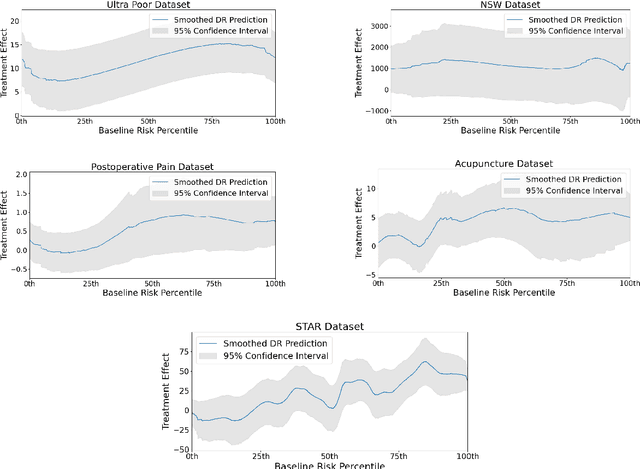
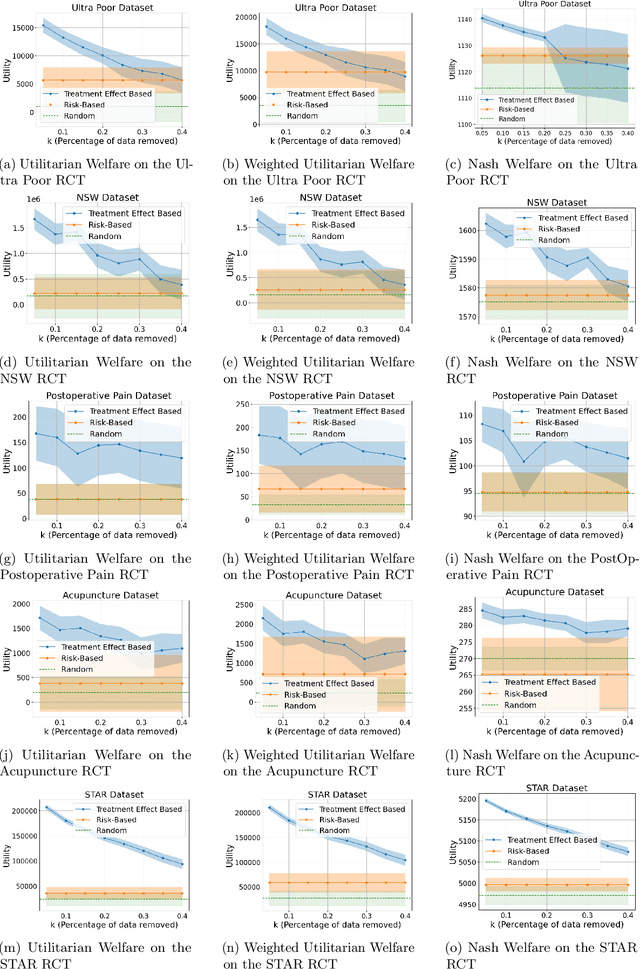
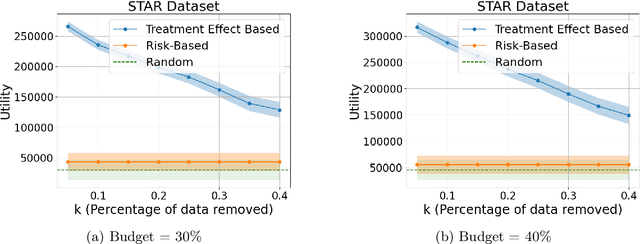
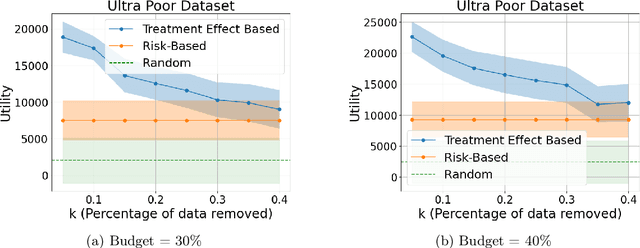
Abstract:Machine learning is increasingly used to select which individuals receive limited-resource interventions in domains such as human services, education, development, and more. However, it is often not apparent what the right quantity is for models to predict. In particular, policymakers rarely have access to data from a randomized controlled trial (RCT) that would enable accurate estimates of treatment effects -- which individuals would benefit more from the intervention. Observational data is more likely to be available, creating a substantial risk of bias in treatment effect estimates. Practitioners instead commonly use a technique termed "risk-based targeting" where the model is just used to predict each individual's status quo outcome (an easier, non-causal task). Those with higher predicted risk are offered treatment. There is currently almost no empirical evidence to inform which choices lead to the most effect machine learning-informed targeting strategies in social domains. In this work, we use data from 5 real-world RCTs in a variety of domains to empirically assess such choices. We find that risk-based targeting is almost always inferior to targeting based on even biased estimates of treatment effects. Moreover, these results hold even when the policymaker has strong normative preferences for assisting higher-risk individuals. Our results imply that, despite the widespread use of risk prediction models in applied settings, practitioners may be better off incorporating even weak evidence about heterogeneous causal effects to inform targeting.
Failure Modes of LLMs for Causal Reasoning on Narratives
Oct 31, 2024

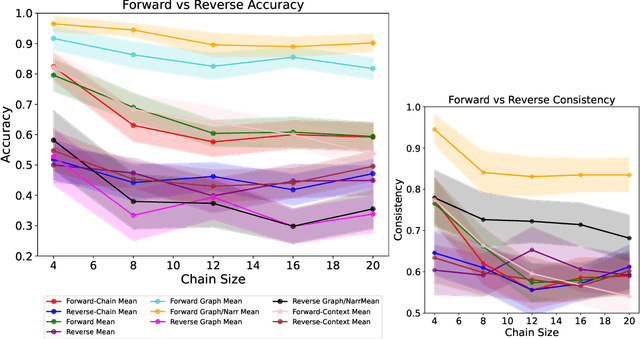
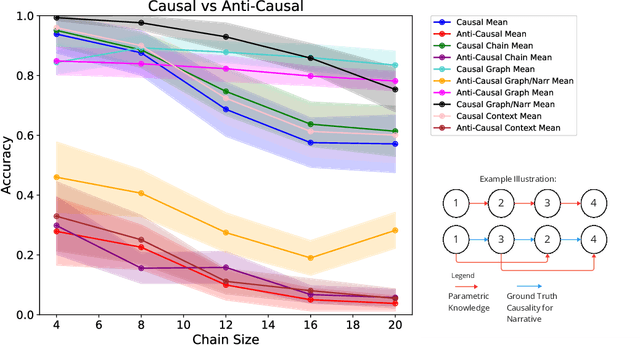
Abstract:In this work, we investigate the causal reasoning abilities of large language models (LLMs) through the representative problem of inferring causal relationships from narratives. We find that even state-of-the-art language models rely on unreliable shortcuts, both in terms of the narrative presentation and their parametric knowledge. For example, LLMs tend to determine causal relationships based on the topological ordering of events (i.e., earlier events cause later ones), resulting in lower performance whenever events are not narrated in their exact causal order. Similarly, we demonstrate that LLMs struggle with long-term causal reasoning and often fail when the narratives are long and contain many events. Additionally, we show LLMs appear to rely heavily on their parametric knowledge at the expense of reasoning over the provided narrative. This degrades their abilities whenever the narrative opposes parametric knowledge. We extensively validate these failure modes through carefully controlled synthetic experiments, as well as evaluations on real-world narratives. Finally, we observe that explicitly generating a causal graph generally improves performance while naive chain-of-thought is ineffective. Collectively, our results distill precise failure modes of current state-of-the-art models and can pave the way for future techniques to enhance causal reasoning in LLMs.
Accounting for Missing Covariates in Heterogeneous Treatment Estimation
Oct 21, 2024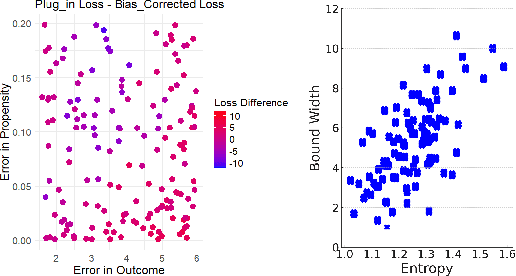
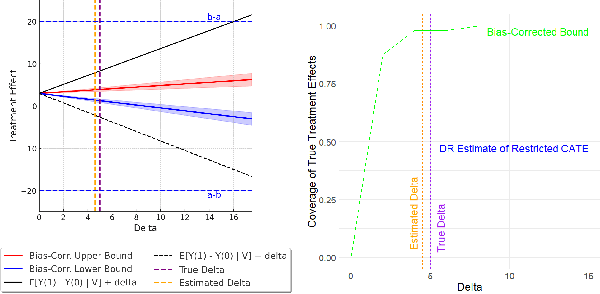
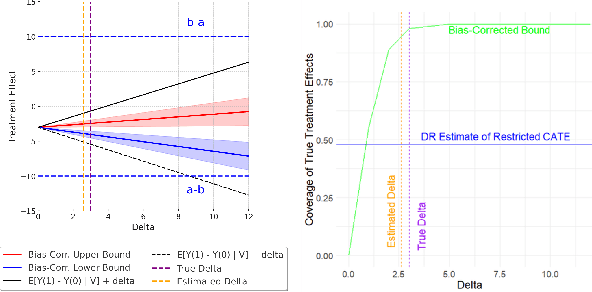
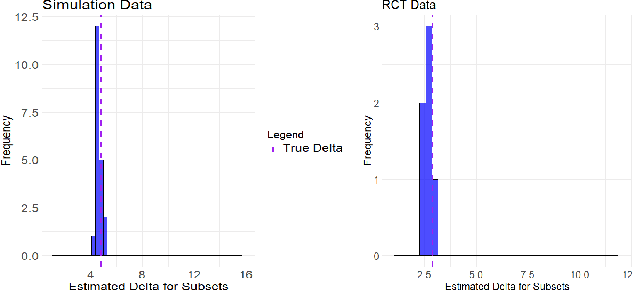
Abstract:Many applications of causal inference require using treatment effects estimated on a study population to make decisions in a separate target population. We consider the challenging setting where there are covariates that are observed in the target population that were not seen in the original study. Our goal is to estimate the tightest possible bounds on heterogeneous treatment effects conditioned on such newly observed covariates. We introduce a novel partial identification strategy based on ideas from ecological inference; the main idea is that estimates of conditional treatment effects for the full covariate set must marginalize correctly when restricted to only the covariates observed in both populations. Furthermore, we introduce a bias-corrected estimator for these bounds and prove that it enjoys fast convergence rates and statistical guarantees (e.g., asymptotic normality). Experimental results on both real and synthetic data demonstrate that our framework can produce bounds that are much tighter than would otherwise be possible.
Decision-Focused Uncertainty Quantification
Oct 02, 2024Abstract:There is increasing interest in ''decision-focused'' machine learning methods which train models to account for how their predictions are used in downstream optimization problems. Doing so can often improve performance on subsequent decision problems. However, current methods for uncertainty quantification do not incorporate any information at all about downstream decisions. We develop a framework based on conformal prediction to produce prediction sets that account for a downstream decision loss function, making them more appropriate to inform high-stakes decision-making. Our approach harnesses the strengths of conformal methods--modularity, model-agnosticism, and statistical coverage guarantees--while incorporating downstream decisions and user-specified utility functions. We prove that our methods retain standard coverage guarantees. Empirical evaluation across a range of datasets and utility metrics demonstrates that our methods achieve significantly lower decision loss compared to standard conformal methods. Additionally, we present a real-world use case in healthcare diagnosis, where our method effectively incorporates the hierarchical structure of dermatological diseases. It successfully generates sets with coherent diagnostic meaning, aiding the triage process during dermatology diagnosis and illustrating how our method can ground high-stakes decision-making on external domain knowledge.
Learning treatment effects while treating those in need
Jul 10, 2024



Abstract:Many social programs attempt to allocate scarce resources to people with the greatest need. Indeed, public services increasingly use algorithmic risk assessments motivated by this goal. However, targeting the highest-need recipients often conflicts with attempting to evaluate the causal effect of the program as a whole, as the best evaluations would be obtained by randomizing the allocation. We propose a framework to design randomized allocation rules which optimally balance targeting high-need individuals with learning treatment effects, presenting policymakers with a Pareto frontier between the two goals. We give sample complexity guarantees for the policy learning problem and provide a computationally efficient strategy to implement it. We then apply our framework to data from human services in Allegheny County, Pennsylvania. Optimized policies can substantially mitigate the tradeoff between learning and targeting. For example, it is often possible to obtain 90% of the optimal utility in targeting high-need individuals while ensuring that the average treatment effect can be estimated with less than 2 times the samples that a randomized controlled trial would require. Mechanisms for targeting public services often focus on measuring need as accurately as possible. However, our results suggest that algorithmic systems in public services can be most impactful if they incorporate program evaluation as an explicit goal alongside targeting.
 Add to Chrome
Add to Chrome Add to Firefox
Add to Firefox Add to Edge
Add to Edge